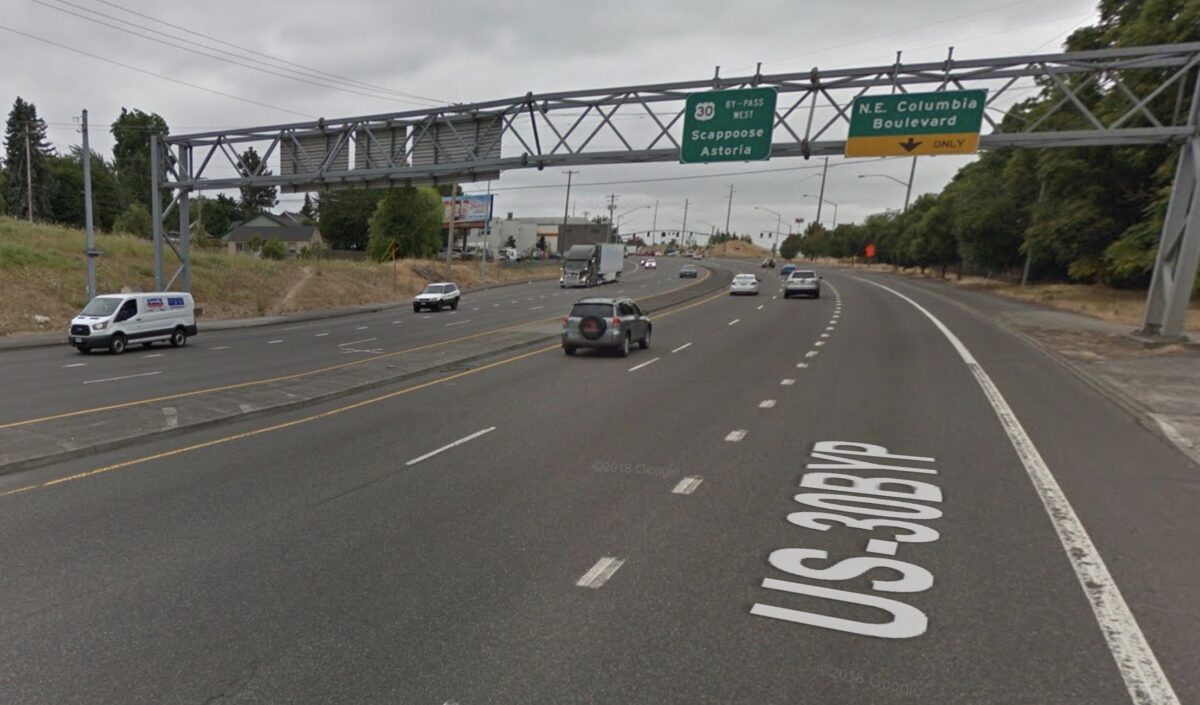
A bicycle rider has died as the result of a collision with an automobile user.
According to the Portland Police Bureau, the crash happened in the westbound lanes of the 9100 block of NE Killingsworth Street around 10:15 pm last night (Friday, 3/1).
Here’s more from the PPB statement released this morning:
“The investigation continues into last night’s fatal traffic crash. Investigators have determined a bicyclist was struck and killed on Northeast Killingsworth Blvd in the 9100 block. The driver of the vehicle was travelling westbound on Northeast Killingsworth when they struck the bicyclist. First aid efforts were started by community members who witnessed the crash but were not successful.
The driver of the vehicle remained on scene and cooperated with the investigation. Neither alcohol nor speed were believed to be factors in this crash. The Multnomah County District Attorney’s Office was consulted during this investigation as well. The driver was not cited as a result of this crash.”
Advertisement
Deadly crash – looks like this maybe involved a cyclist. We can see a body lying in the road…don’t worry that’s not visible in this photo. TRAFFIC ALERT: Both lanes of NE Killingsworth from 205 to Columbia Blvd are closed. We’re live at 11. #pdxtraffic #portland #fox12 pic.twitter.com/5YfZnuHva0
— Bonnie Silkman KPTV (@BonnieSilkman) March 2, 2019
This section of NE Killingsworth (also known as US Highway 30) is just west of cloverleaf interchanges and ramps for Interstate 205. It’s an extremely stressful place to ride a bike and it does not see much cycling traffic. The cross-section is four lanes in the westbound direction, including one unprotected, four-five foot wide bicycle-only lane. The speed limit on this section of Killingsworth is 45 mph. At those speeds, a vulnerable road user has only a 10 percent chance of survival if they are struck by a driver.
Below are two overhead views of where this happened. Note how wide the cross-section is and the proximity of the freeway ramps:
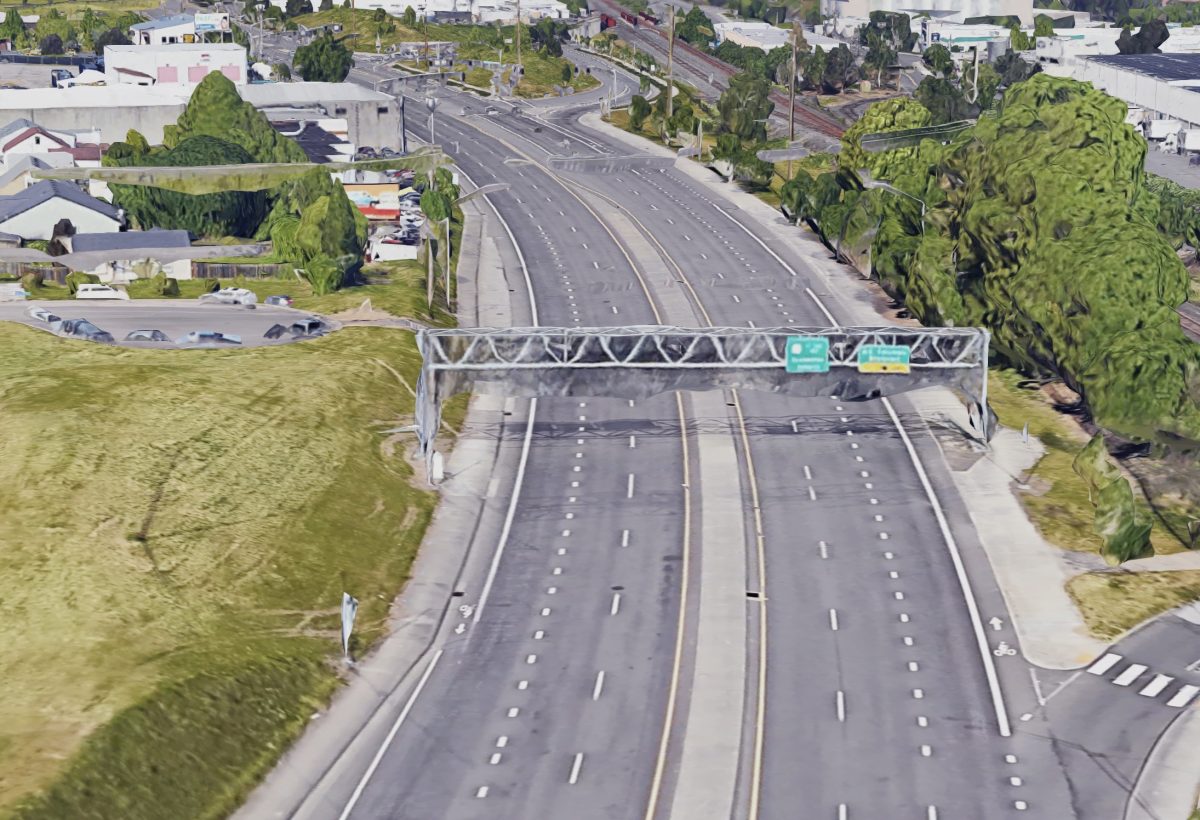
This is the fifth fatal traffic collision in Portland so far this year and the first one involving a bicycle rider. The victims of the first four deaths this year were walking prior to being struck.
We’ll share more information as we learn more. If you saw this crash and have any information to share, please contact us and the PPB non-emergency line at (503) 823-3333.
— Jonathan Maus: (503) 706-8804, @jonathan_maus on Twitter and jonathan@bikeportland.org
Never miss a story. Sign-up for the daily BP Headlines email.
BikePortland needs your support.


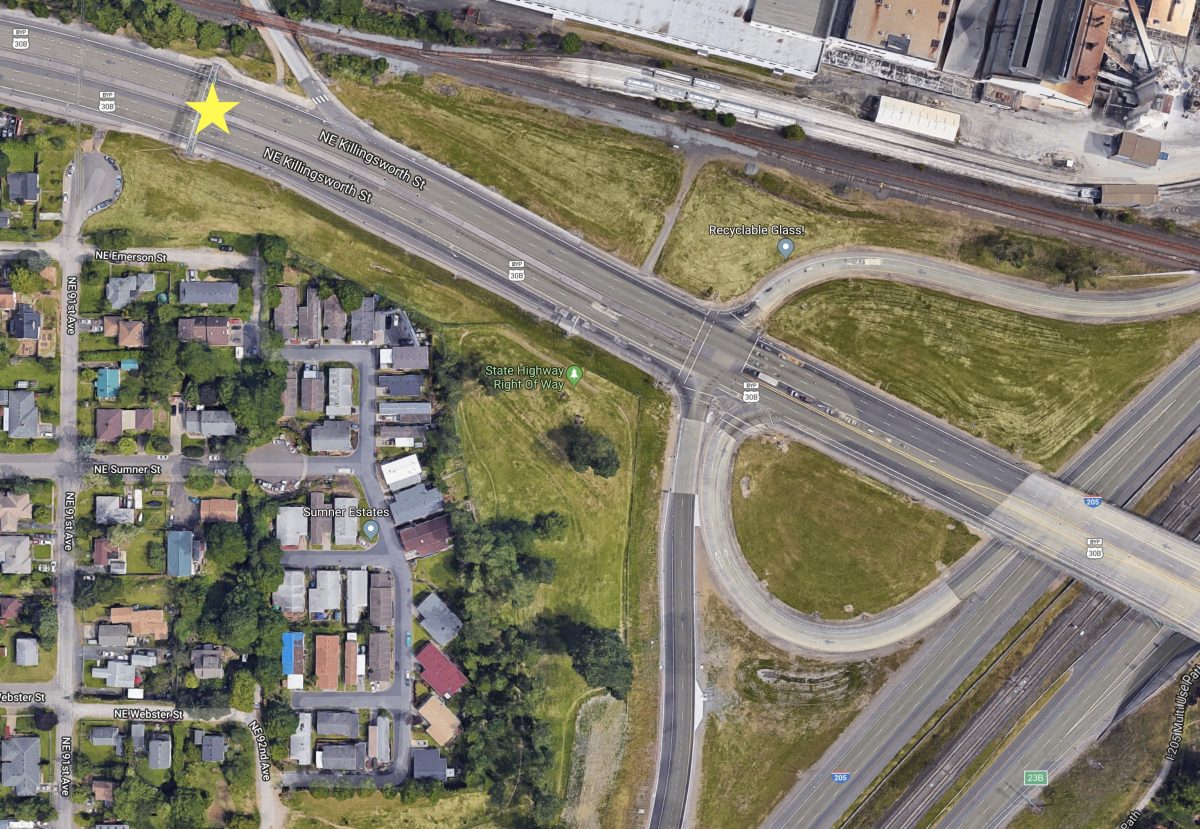
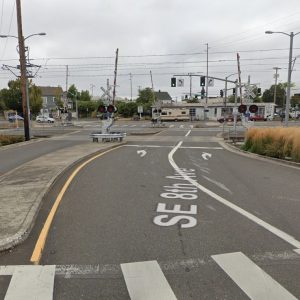
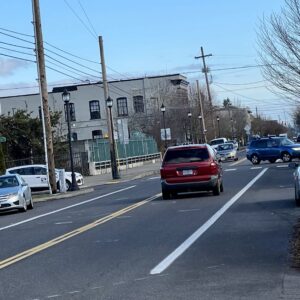
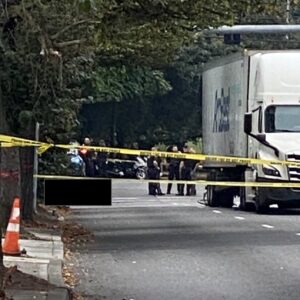
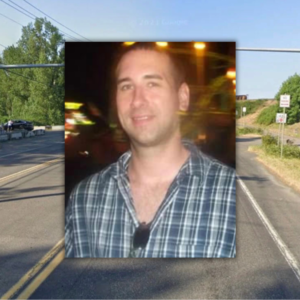
Thanks for reading.
BikePortland has served this community with independent community journalism since 2005. We rely on subscriptions from readers like you to survive. Your financial support is vital in keeping this valuable resource alive and well.
Please subscribe today to strengthen and expand our work.
45mph zone. Why do we have speed limits this high on shared roads in the city? (west hills have a lot of this problem too) It’s insane. The survival statistics alone should end this practice. I’ll happily spend a few more minutes in traffic getting where I’m going to have them reduced and have lives (quite possibly my own some day) saved.
Ideally, this roadway needs protected bike lanes and protected intersections; the bike lane shown is so 1970s. But given a lack of funding and greater priorities elsewhere, is it better to have a minimalist bike lane on this section of street, or to have no bike lane at all?
This a 35 mph zone, they reduced the speed limit on that stretch from 67th east years ago. Live in the area and no one rides that section in the daytime let alone at night because it’s such a cluster of traffic no matter what the speed limit.
Even worse is the Sandy Blvd/Killingsworth crossing N/S back onto the I-205 bike path which is my daily commute. I’ve been talking with ODOT for years (PBOT doesn’t have jurisdiction) about the safety issue with zero traction. Major connector and unbelievable the disdain for our safety except the recent addition of a THIRD vehicle lane east bound on Sandy instead of a bike lane…
No it drops to 35 at 82nd until but the stretch where this happened is 45. It goes back to 45 again at Cully. I’ve led the cully pub crawl for like 10 years now for pedalpalooza and we have never gone to any of the pubs north of killingsworth because I have never felt it would be safe to get there with a group.
First, my condolences. I know this unpopular route well, and suffice to say the empathy comes naturally.
I don’t wish to be prescriptive about a solution, but do want to say that a good east/west route in East(-ish) Portland is like a good north/south route in inner Portland. And the Easter Bunny.
What, at minimum, do city, county, and state transportation agencies do about any fatal incident within their jurisdiction? How does it differ for the roads they do not maintain?
I ask because I’d hate to find out that PBOT just shrugs and says that its Vision Zero policy only applies to bureau-maintained roads inside city limits. At the same time, would it be a surprise?
No citation….but yet…cops are handing out citations like candy on Ladd’s circle
Are they?
In the past, I’ve gotten the idea that no immediate citation means authorities are reserving the option of handing out more than just a citation. To me, it’s an indication of a potentially more serious charge pending, or at least a possibility of multiple citations once an investigation is completed.
Of course, it could also result in nothing.
i had the same thought, Mark. I rarely see cars pulled over in this city but have ten or more friends that have received citations from police while biking.
If you really want to understand what’s happening, I’d suggest looking at the statistics rather than relying on your personal network.
When they say speed was not a factor, they must mean that the driver was no more than 11mph over the posted speed. Speed was definitely a factor whenever a person was killed with a car. Faulty engineering was also a factor, starting with paint-only bike lanes and high posted speed. But even the painted bike lane is not continuous and has several conflict points.
Our status-quo cars-first policies and practices have killed yet another person but ODOT, PBOT, and the elected officials responsible are going to continue doing things the same way until they’re held accountable. I’m sure thousands have driven through the blood already.
I think what they mean is that speed was not a primary cause of the crash. If you start from the position that speed is always a factor, it just fades into the background, becoming part of the boilerplate, and no longer serves as a way of classifying different types of incidents.
Acting like speed isn’t a factor in a typical car/VRU crashes where the car is going more than 20mph just demonstrates our collective windshield bias.
Was speed a cause of this crash?
Speed is the cause/a factor in every crash because if the vehicle was not moving there would be no crash.
Similarly, bicycle speed was also a cause/factor. Maybe crash reports should just come prefilled — that would definitely save some time.
exactly. and yes, I have advocated for crash statement templates in the past and I think if PPB used them it would be much better for everyone involved.
to be fair…speed (of the vehicle) is not always a factor.
not trying to be dickish, but the population of accidents where bike ran into a stationary car, a slow moving car, or a car moving laterally across the path of the bike (i.e. near 0 in relation to bikes trajectory) is far greater than 0….and clearly saying “speed was a factor” is not what people are thinking in a case where careless driver turns into a bike…that disaster can happen at 5mph.
again…not meant as an insensitive prickish argument given the situation, just saying “speed is always a factor” suggests that cars are always the major factor in accidents and by extension, if cars weren’t moving, we wouldn’t have accidents…which is just blatantly false.
Having run into a parked car, I can say that the car speed is not always a factor. But, neither I, my yellow stingray, or the car were damaged. When we are talking fatalities, speed is always a factor.
A child runs out into the street-
At 20 MPH the driver is able to stop
At 30 MPH the driver sends the child to the hospital
At 45 MPH the driver kills the child
It is time to stop using blanket statement like “speed was not a factor”.
I think it’s time to stop using blanket statements of any sort — the point of doing an investigation is to learn what happened, and relying on blanket statements undermines that effort.
(And yes, I know that some of these investigations are rather cursory and apparently biased. That is an issue that needs to be addressed, but is independent to whether there should be an investigation in the first place.)
Obviously not a ton of information as of now, but because it is an out of the way spot the north side of killingsworth has become a popular camping spot recently. There are several large camps that have set up here and the folks that are staying there frequently are cutting across the street because the nearest signalized crossing is a little distance away. I have thought that this was a dangerous situation that might result in tragic results as I have watched the camping get worse over the past few months.
Yep, and Johnson Lake (behind the glass plant) has long been another popular natural area for those folks to abuse. If it turns out that this person was “living outdoors” (or whatever we’re calling it this week) then it won’t be the first time that a similar scenario has unfolded: person emerges from somewhere they shouldn’t be, doesn’t have their wits fully about them, and enters a traffic lane at a place where it’s difficult or impossible for a driver to avoid a collision. I can think of at least two incidents (I-205, US 26 tunnel entrance) where this has been the case, and has resulted in fatalities. We can paint bike lanes and build cycletracks all day long but it won’t ensure an intoxicated or disoriented person actually takes advantage of such facilities.
Also makes me wonder what the overall death toll is, for Portland’s hands-off approach to illegal camping.
Yes my condolences for all involved. escpically the deceased victim.
Jonathan – I would recommend describing the motorist as “driver” or “vehicle operator” and not “user”. Unless of course this was an autonomous vehicle.
And this incident may raise the discussion of updating the design of bikeways along high speed access controlled arterials that are too “highway like” in their design especially in low visability conditions like night time.. Perhaps at a minimum such bikeways need reflectorized RPMs and rubble strips etc…if a separated bikeway is not done.
I know Jonathan is trying to emphasize the humans in these situations, but the bicyclist did not die in a collision with an automobile operator; s/he died in a collision with an automobile operated by a human. I know that sounds a tad awkward, but at some level we need to admit that it’s the 4000-pound objects flying down the roads at 45 mph that are killing people, at the behest of human operators. The 40-pound bicycles operated by 180-pound humans are NOT killing people.
The asymmetry you point out nearly makes it impossible to clarify who is controlling what without awkward diction. In the case of a pedestrian or bicyclist, it is literally the “operator” that is struck by whatever they collide with. Usually, the bicycle AND rider are both struck by the other vehicle, while the driver of that vehicle remains untouched. It would be a rare case indeed for a bicyclist to literally collide with a driver.
Maybe we could say that “a bicyclist/pedestrian was struck/collided with a sedan/SUV/Van/Delivery truck operated by an unidentified driver. Thankfully, the driver did not flee the scene.” Or, “the bicyclist was injured in a collision with…”
I truly appreciate Jonathan’s efforts to give agency to the drivers in these situations rather than making it sound like “A Car” was no more than a runaway boulder. We’ll figure out the best wording as time goes on.
For those of you wanting traffic data, this portion of the Business Route US 30 roadway is listed by ODOT as Oregon Highway #123. Annual Average Daily Traffic (both ways): Mile post 10.51, 28300 vehicles/day, location of 0.10 mile east of Cascade Highway North (OR213, NE 82nd Avenue) on Columbia Blvd.
I rode east through this area once to test my potential bike commute. I continued driving to work after that.
I’ve biked through this area trying to find the best /safest route to Bike Tires Direct. It’s safer to drive. Although it has designated bike lanes it is surely designed with the intent of moving auto traffic and commercial trucks through as quickly and efficiently as possible, and it feels very intimidating to cycle in this area.
East on Prescott to 89th then scoot down the Columbia Parkway N. It has a bike lane and a sidewalk, which is good, because it rivals Hwy 30 for the amount of crap in the lane. The problem is getting back You’ll have to ride E on Killingsworth for a couple of blocks to get back to the safety of 89th. (And, of course, no bike lane on Prescott….).
all y’all’s talk about increasing penalties and speed limits and whatnot are entirely moot. You are talking into the wind at this point. The laws are not being enforced as it is. What will it take to expedite matters and enable enforcement to become a viable reality again? That is the real problem. And i do not see a way to get there.
Everyone is too selfish and all about getting themselves where they want to go as fast as possible. God help any of us who get in their way.
Portland could start with dedicating more than ~5 officers to patrol the entire city.
Sure, but when they’re already short staffed, where is that extra staffing going to come from?
I don’t know the true numbers, but Wikipedia says PPB has 1000 full-time officers. If that’s close to correct, then the low number of officers in the traffic division is just a matter of priorities.
What should be deprioritized? If you can make a list, that would totally be something you could send to the mayor, who is both an elected official and directly in charge of setting police priorities.
amen
“This is the fourth fatal traffic collision in Portland so far this year”
You may have missed the pedestrian one Friday morning.
https://www.kptv.com/news/officers-id-woman-who-died-at-hospital-after-being-struck/article_a6b5c238-3c3b-11e9-975c-73a07cd37726.html
SE 92nd & Holgate. A nasty corner. I know it all too well. Lents Park on one corner and the other three corners all have auto-oriented stores with too many driveways too close to the signalized intersection. Everyone in a hurry. Standard bike lanes on 92nd and buffered bike lanes on Holgate west of 92nd. Why Holgate needs separate left turn AND right turn lanes is beyond me. I’d love to get a PBOT explanation on this one, vis-a-vis Vision Zero, as both Holgate and 92nd are one-lane each direction, in all 4 directions. Doesn’t adding the turn lanes just encourage car drivers to turn faster?
i live just down the way at 84th and holgate, and can confirm that intersection is totally fucked.
Yes I did miss that one. I’ve updated the tally and the post. Thanks for the heads up.
This is in my neighborhood and it’s really time for cycling improvements to both east and westbound Killingsworth in this area. No one obeys the speed limit and eastbound lane crossing over the 205 on-ramp is so dangerous.
Maybe it’s time for there to not allow standard bike lanes on roads with speed limits over 30 mph. It just doesn’t seem like the city/ODOT should encourage cycling in areas that leave cyclists so vulnerable.
The Dutch engineering manual for bicycles on the road(CROW Manual) prohibits bike lanes on streets with speed limits that high, and generally cuts bike lanes from the list at 25 MPH (40 km/hr). The sad thing for me is the minimum posted speed limit in TX is 25 MPH after an act of the legislature for that specific road or street, otherwise it’s 30 MPH.
I’ve seen so many homeless walking bikes across the street near the chop shop that the photos were taken from that I would not even categorize the person with a bike as a cyclist. Facts matter.
Being a decent human being matters too.
wideangle,
Just FYI, I don’t think it’s wise to ever “categorize” anyone based on what type of vehicle they are using.
Unless it is an F-150 with WA tags. I am more than happy to stereotype them.
We are quick to blame the motorist here (as always). Are we sure the bike rider was not under the influence of a substance and veered into the car lane?
I don’t think we are sure of anything at this point as the investigation is still going on.
But we can assume all we want 🙂
We’re not even sure there was a motorist.
Condolences to the cyclist, family, and friends. This stretch is sketchy for many reasons. The cars are one reason. There’s also a lot of gravel and small trash in the bike lane which could be tricky to navigate. Besides the adrenaline of the passing cars, there is a tiny 1.5% incline going west which could add to the adrenaline for any cyclist, especially if they’re already pedaling fast from the cars. I’ve done this stretch about 15-20 times or so. One time I was doing this route with a friend, got freaked out by the cars when I was looking to make sure I could still stay in the bike lane (it’s where the bike lane goes straight, but really goes left because the car lane merges right), and embarrassingly hit the curb and crashed. Sometimes I would take the sidewalk instead which I know is a big no-no, but there is rarely pedestrian traffic in this area.
There’s no shame in riding the sidewalk in this area. Cars going 2x as fast as you just 1 foot away would make a lot of people opt for the sidewalk.
Regarding speeding this would be a start (because enforcement by police will never suffice): https://www.forbes.com/sites/carltonreid/2019/02/27/all-new-cars-to-have-speed-limiters-fitted-rules-european-parliament/
“The driver of the vehicle was travelling westbound”
So far we don’t know what type of vehicle the driver was piloting. At this point it could have been another cyclist that ran into them and killed them.
Of course we all know it’s likely to be some sort of motor vehicle. But the lack of details seems like really poor reporting, even for a police statement.
The PPB release says that their (PIO) Public Information Office didn’t respond to the crash scene. Does this mean we got a press release with less info than usual? Or did we get it from somebody other than the PIO?
Sure, because you know, why not hand out a citation when it actually happens-which would be recorded in the paper? That would be, you know, too logical.
Why would it be logical to write a citation before the investigation?
Exactly